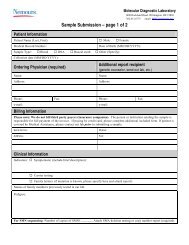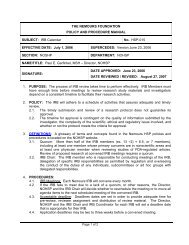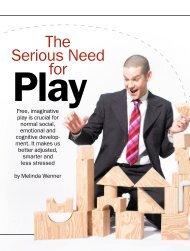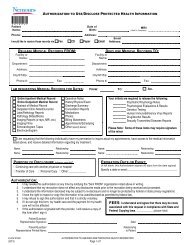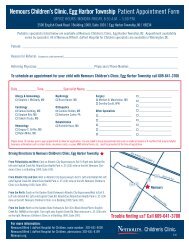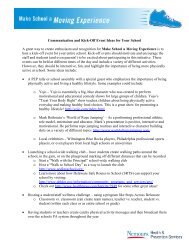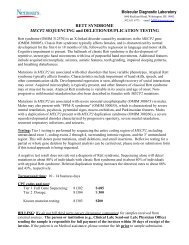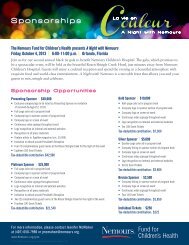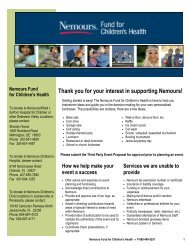Best Practices for Physical Activity: - Nemours
Best Practices for Physical Activity: - Nemours
Best Practices for Physical Activity: - Nemours
- No tags were found...
You also want an ePaper? Increase the reach of your titles
YUMPU automatically turns print PDFs into web optimized ePapers that Google loves.
<strong>Best</strong> <strong>Practices</strong> <strong>for</strong> <strong>Physical</strong> <strong>Activity</strong>:A Guide To Help Children Grow Up HealthyFor Organizations Serving Children and Youth
Table of ContentsIntroduction 4<strong>Physical</strong> <strong>Activity</strong> Tips 6Glossary of Terms 7<strong>Physical</strong> <strong>Activity</strong> Guidelines 8Infants 8Toddlers 9Preschoolers 10School Age 11Sample Policies 12Sample Policies <strong>for</strong> Child Care 13Delaware Office of Child Care Licensing Regulations Related to<strong>Physical</strong> <strong>Activity</strong> and Screen Time 15Sample Policies <strong>for</strong> School 16Frequently Asked Questions 18References 20Parent and Family Tip Sheets 22Birth through 11 months 231 through 2 years old 253 through 5 years old 276 years and older 29
Introduction<strong>Nemours</strong> Health and Prevention Services (NHPS) created these physical activity guidelines to help promoteand support quality physical activity <strong>for</strong> children and youth. All who care about children and want to seethem achieve their full potential have a role to play in helping them grow up to be healthy adults. Thosewho work in child care centers, schools, community organizations or primary health care practices havepowerful opportunities to ensure children have access to health-promoting physical activity on a dailybasis. Equipped with in<strong>for</strong>mation about best practices, parents, family members and neighbors can serveas important advocates to ensure that physical activity becomes a regular and enjoyable part of daily life<strong>for</strong> children.When children are physically active on a daily basis, not only are they more effective learners, but they areless likely to be overweight or obese. In Delaware, approximately 30% of young children aged 2-5 andapproximately 37% of all children 2-18 are obese or overweight. 1 Overweight and obese children havean increased risk of being overweight or obese as adults and are at high risk <strong>for</strong> developing immediatehealth problems such as type 2 diabetes, heart disease, high blood pressure, asthma, and sleep apnea. 2-10 Inaddition, obese children are at greater risk <strong>for</strong> social and psychological problems, such as stigmatizationand poor self-esteem. 11,12To slow down and reverse the trend towards higher rates of childhood obesity, NHPS partners withprimary care providers, school districts, child care providers and after school programs throughoutDelaware to provide children with opportunities to be physically active in places where they live, learnand play. Together, we can help Delaware’s children become the healthiest in the nation.Children who are physically active early in life and stay active throughout childhood enjoy many positivebenefits to their physical health, building strength, flexibility, endurance and developing and maintaininghealthy bones. 13-16 In addition, being physically active supports emotional health, reducing feelings ofanxiety and depression, while promoting psychological well-being. 13,16,17 It is important to provide apositive environment <strong>for</strong> physical activity by giving children of all ages daily opportunities to be physicallyactive, surrounded by positive and responsive adult role models.Children who have active parents and family members and do regular activities with them are more likelyto be active than those who are not active in the family setting. 18,19 Adults who demonstrate enjoyment ofphysical activity, encourage children to explore the world around them, support child-initiated activity,plan thoughtful structured activity and play with children are helping to lay a strong foundation <strong>for</strong> lifelonghealth.To help you promote and support quality physical activity in your setting, this guide provides:• <strong>Physical</strong> activity guidelines <strong>for</strong> children birth through 18 years of age;• Concrete examples you can use to support the guidelines;• Rationale <strong>for</strong> the guidelines;• Sample child care policies;• Office of Child Care Licensing Regulations <strong>for</strong> physical activity;• Sample school policies; and• Parent and Family Tip Sheets.4 <strong>Best</strong> <strong>Practices</strong> <strong>for</strong> <strong>Physical</strong> <strong>Activity</strong>4 <strong>Best</strong> <strong>Practices</strong> <strong>for</strong> <strong>Physical</strong> <strong>Activity</strong>
Glossary of TermsTummy time is the time an infant spendson his stomach (tummy) throughout theday. Tummy time is only <strong>for</strong> when theinfant is awake; you should continueto put infants to sleep on their backs toreduce the risk of sudden infant deathsyndrome (SIDS). Also, spending timeon their tummies builds the strength andcoordination needed to reach movementmilestones, including rolling over, sitting up,and crawling. 23,24Sedentary activity is non-moving activity likereading, playing a board game or drawing.Sedentary activity does not provide muchphysical activity and/or exercise. 25Vigorous-intensity physical activity isrhythmic, repetitive physical activity thatuses large muscle groups, causing a child tobreathe rapidly and only enabling them tospeak in short phrases. Typically children’sheart rates are substantially increased andthey are likely to be sweating. 22Moderate-intensity physical activity increases your heart rate and breathing rate. You may sweat, but you are still ableto carry on a conversation. You can talk, but you can’t sing. 21,22Moderate-to-Vigorous physical activity (MVPA) is a combination of moderate and vigorous intensity physicalactivity. 21,22Structured physical activity is teacher-led, developmentally appropriate and fun. Structured activity should include:• Daily planned physical activity that supports age-appropriate motor skill development. The activityshould be engaging and involve all children with minimal or no waiting.• Daily, fun physical activity that is vigorous (gets children “breathless” or breathing deeper and fasterthan during typical activities) <strong>for</strong> short doses of time.Unstructured physical activity is child-led free play. Unstructured activity should include:• Activities that respect and encourage children’s individual abilities and interests.• Teacher engagement with children, support <strong>for</strong> extending play, and gentle prompts and encouragementby teachers, when appropriate, to stay physically active.A Guide To Help Children Grow Up Healthy 7
Infants:Birth through 11 monthsRecommendedTummy time is recommended at least 2-3times per day <strong>for</strong> short intervals or astolerated by the infant in a safe settingsupervised by an adult.Daily planned physical activities thatsafely support the infant’s developmentalmilestones are recommended (e.g. headand neck self-support, rolling, floorsitting, kicking, crawling, reaching andgrasping <strong>for</strong> objects, etc.).Daily outdoor time in a safe settingsupervised by an adult.Large, open, safe play surfaces andappropriate equipment should beprovided in every infant room to promotefree movement and physical activity:rattles, balls, simple cause and effecttoys, etc.61LimitWhile awake, infants should spend lessthan 20 minutes a day in confiningequipment. Examples:• Swings• Bouncy chairs• Car seats• StrollersNot RecommendedScreen time <strong>for</strong> children under two yearsof age. Screen time includes:• TV or DVDs• Computer• Video gamesInfant walkers and exercise saucers<strong>Physical</strong> activity that is notdevelopmentally appropriate.Includes but is not limited to:• Running• Throwing• Catching• Overly structured activities thatdo not interest or engage infantsSource: National Association <strong>for</strong> Sport and <strong>Physical</strong> Education. Active start: A Statement of <strong>Physical</strong> <strong>Activity</strong> Guidelines <strong>for</strong> Children Birth to Five Years. 2 nd ed; 2002.Ways to support the recommendations 26• <strong>Physical</strong> activity should be encouraged when the infantis awake and interested and should be supervised byan adult.• Until an infant is creeping or crawling, provide at least30 minutes of tummy time daily. Get down on thefloor during tummy time, face to face, so that you cantalk, sing and explore together.• Plan safe, engaging activities both indoors andoutdoors. Examples of “motor skills” include simplegames, kicking, dancing, and yoga.• Provide a safe and engaging environment to explorethrough the use of rattles, mobiles, mirrors; <strong>for</strong> olderinfants add balls, dolls, simple cause and effect toysand solid furniture to use <strong>for</strong> pulling up.• Place infants on blankets or other safe, dry surfaceswith favorite toys nearby to encourage reaching, freemovement and exploration indoors and outdoorseach day.• Share in<strong>for</strong>mation about healthy habits with familiesthrough conversations, newsletters and special events.8 <strong>Best</strong> <strong>Practices</strong> <strong>for</strong> <strong>Physical</strong> <strong>Activity</strong>
Toddlers:1 through 2 years oldRecommendedDaily, toddlers need:• At least 30 minutes of structuredactivity,• At least 60 minutes and up toseveral hours of unstructuredphysical activity* This can be done in small doses of 10 minutesthroughout the dayDaily outdoor time in a safe settingsupervised by an adult.Free space, developmentally appropriatetoys and equipment to encourage childrento be physically active: riding toys, balls,large blocks, tunnels, rocking boats, lowclimbers, etc.It is important to encourage participation inphysical activities that are appropriate <strong>for</strong>their age, that are fun, and that offer variety.61LimitToddlers should spend less than20 minutes per day in confiningequipment while awake. Examples:• Car seats• StrollersLimit screen time to under one hour* aday <strong>for</strong> children two and older. Screentime should be supervised. Parentpermission should be requested <strong>for</strong>children participating in any screentime. This includes:• TV / DVDs• Computer• Video gamesNot RecommendedScreen time <strong>for</strong> children under two years ofage. Screen time includes:• TV or DVDs• Computer• Video gamesMore than 60 minutes of sedentary activityat a time, except while sleeping.Infant walkers<strong>Physical</strong> activity that is notdevelopmentally appropriate.Includes but not limited to:• Hopping on one foot• Skipping• Climbing on the monkey bars• Competitive gamesSource: National Association <strong>for</strong> Sport and <strong>Physical</strong> Education. Active start: A Statement of <strong>Physical</strong> <strong>Activity</strong> Guidelines <strong>for</strong> Children Birth to Five Years. 2 nd ed; 2002.Ways to support the recommendations 26• Model enjoyment of physical activity by joining childrenin ball play, dancing, games and other physical activities.• Build time in your schedule <strong>for</strong> daily, planned structuredphysical activity that supports age-appropriate motorskill development (walking, running, throwing, kicking,etc.). The activity should be engaging, fun, and involveall children with minimal or no waiting.• Plan various fun physical activities that are vigorous (getchildren “breathless” or breathing deeper and faster thanduring typical activities) <strong>for</strong> short doses of time (ridingtoys, navigating an obstacle course, jumping, etc).• Play games that incorporate music, imitation and simpledirections such as animal movements, follow the leaderor dancing with scarves.• Provide small objects to roll, toss and kick, such asbeanbags and balls.• Offer toys that increase spatial awareness andcoordination such as push toys (lawn mowers or dollcarriages) or pull toys (wagons and riding toys).• Provide opportunities to jump using mats, pillows, orlines on the floor.• Provide activities to encourage balance: walking abalance beam line on the floor, or on different texturedor uneven surfaces, with support when appropriate.• Offer ramps, steps, low climbers, and obstacle courses tobuild skills, strength, coordination and confidence.• Share in<strong>for</strong>mation about healthy habits with familiesthrough conversations, newsletters and events.*<strong>Nemours</strong> recommends children two years of age and older spend less than two hoursper day in front of a screen. We recommend limiting screen time to one hour or less inchild care with the knowledge that children will be likely to get additional screen timeat home, and to align with Delaware Office of Child Care Licensing regulations.A Guide To Help Children Grow Up Healthy 9
Preschoolers:3 through 5 years oldRecommendedDaily, preschoolers need:• At least 60 minutes of structuredactivity,• At least 60 minutes and up to severalhours of unstructured physicalactivity* This can be done in small doses of 10 minutesthroughout the dayDaily outdoor time in a safe settingsupervised by an adult.Free space, developmentally appropriate toysand equipment to encourage children to bephysically active: tricycles, yoga mats, balls,rocking boats, hopscotch, hoops, etc.It is important to encourage participation inphysical activities that are appropriate <strong>for</strong>their age, that are fun, and that offer variety.LimitLimit screen time to under one hour* aday. Screen time should be supervised.Parent permission should be requested <strong>for</strong>children participating in any screen time.This includes:• TV / DVD• Computer• Video games.Not RecommendedMore than 60 minutes of sedentaryactivity at a time, except while sleeping.<strong>Physical</strong> activity that is notdevelopmentally appropriate. Whichincludes but is not limited to:• Riding a 2-wheel bike• Roller skating/blading• Elimination gamesMore than 1 hour of screen time.Source: National Association <strong>for</strong> Sport and <strong>Physical</strong> Education. Active start: A Statement of <strong>Physical</strong> <strong>Activity</strong> Guidelines <strong>for</strong> Children Birth to Five Years. 2 nd ed; 2002.Ways to support the recommendations 26• Model enjoyment of physical activity by joining childrenin ball play, dancing, yoga, stepping, active games andother fitness activities.• Build time in your schedule to include daily plannedstructured physical activity that supports age-appropriatemotor skill development (jumping, skipping, hopping,etc.). The activity should be engaging, fun, and involveall children with minimal or no waiting.• Plan various fun physical activities that are vigorous (getchildren “breathless” or breathing deeper and fasterthan during typical activities) <strong>for</strong> short doses of time(riding tricycles, dancing to music, navigating an obstaclecourse, playing tag, etc.).• Play games that incorporate music, imitation and simpledirections such as animal movements, follow the leaderor dancing with scarves.• Plan safe, engaging activities outdoors: hopscotch,tricycle motocross, freeze tag, parachute games, etc.10 <strong>Best</strong> <strong>Practices</strong> <strong>for</strong> <strong>Physical</strong> <strong>Activity</strong>• Offer ramps, steps, low climbers and obstacle courses tobuild skills, strength, coordination, and confidence.• Develop movement stations indoors or outdoors sochildren can practice developing skills: throwing,catching, kicking, balancing, changing direction,jumping, hopping, skipping, galloping, etc.• Provide activities to encourage balance: standing on onefoot or walking a balance beam line on the floor, or ondifferent textured or uneven surfaces.• Provide opportunities to jump and hop using mats,pillows, or lines on the floor.• Encourage children to work together to create their owngames.• Help children recognize their own faster heart rate anddeeper breathing when they are physically active.• Share in<strong>for</strong>mation about healthy habits with familiesthrough conversations, newsletters and events.*<strong>Nemours</strong> recommends children two years of age and older spend less than two hoursper day in front of a screen. We recommend limiting screen time to one hour or less inchild care with the knowledge that children will be likely to get additional screen timeat home, and to align with Delaware Office of Child Care Licensing regulations.
School Aged:6 years old and olderRecommendedDaily, school aged children need:• At least 60 minutes of physicalactivity,• Aerobic as well as age-appropriatemuscle- and bone-strengtheningactivities* This can be done in small doses of 10minutes throughout the dayDaily outdoor time.It is important to encourage participationin physical activities that are appropriate<strong>for</strong> their age, that are fun, and that offervariety.LimitLimit screen time to under one hour*a day. In after school settings, parentpermission should be requested <strong>for</strong>children participating in any screen time.This includes:• TV / DVD• Computer• Video games.Not RecommendedMore than 120 minutes (2 hours) ofsedentary activity at a time.More than 1 hour of screen time.Elimination games.US Department of Health and Human Services. 2008 <strong>Physical</strong> <strong>Activity</strong> Guidelines <strong>for</strong> Americans. http://www.health.gov/paguidelines. October 17, 2008. Accessed April 2009.Ways to support the recommendations• Play games that incorporate music, imitation and simpledirections where children are the leaders.• Play games that incorporate strength, coordination andconfidence; finding hidden objects, relay races, obstaclecourses, variety of “tag” games, tug-of-war.• Encourage children to adapt or invent their own games.• Provide safe objects to throw, kick and catch.• Provide playground equipment <strong>for</strong> climbing.• Share in<strong>for</strong>mation about healthy habits with familiesthrough conversations, newsletters and events.• Support and supervise child-led free play, which is alsocalled unstructured physical activity.• Encourage children’s individual abilities and interests.• Engage children, provide support <strong>for</strong> extending play,and give gentle prompts and encouragement, whenappropriate, to stay physically active.• Provide free space, toys and equipment to encouragechildren to be physically active: climbers, monkey bars,yoga mats, balls, balance beams, hopscotch, hoops, etc.<strong>Physical</strong> <strong>Activity</strong> should include:Moderate- or vigorous-intensity aerobic physical activity <strong>for</strong>the majority of the 60 minutes a day and vigorous-intensityphysical activity at least 3 days a week. 13Daily planned physical activity that is engaging and involvesall children with minimal or no waiting time.Muscle strengthening or resistance activities as part of the 60or more minutes on at least 3 days of the week. 13 Activitiesshould be fun and can include: movements that strengthenmuscles without weights, <strong>for</strong> instance using playgroundstructures (e.g. monkey bars, rock climbing walls), as wellas movements that strengthen muscles with weights (e.g.working with resistance bands).Bone-strengthening activities as part of the 60 or moreminutes on at least 3 days of the week to promotebone growth and strength (e.g. running, jumping rope,hopscotch). 13Vigorous physical activity aiming <strong>for</strong> at least 10 minutes perday (e.g. running, martial arts, active games that involverunning and chasing). 13*<strong>Nemours</strong> recommends children two years of age and older spend less than two hoursper day in front of a screen. We recommend limiting screen time to one hour or less inchild care with the knowledge that children will be likely to get additional screen timeat home, and to align with Delaware Office of Child Care Licensing regulations.A Guide To Help Children Grow Up Healthy 11
Sample PoliciesSample Child Care Policy SupportFor Program, Staff, And FamilyHandbooksPolicy can make your practices known,understood and supported by staff,families and older children. When youdevelop policy statements <strong>for</strong> yourhandbooks and orientation materials,your preferred practices are more likelyto be permanent, even with changes inyour center or staff. The following aresome sample statements that you canadd to your policies and proceduresto make your child care center moresupportive of physical activity. Yourpolicy statements can help staff andfamilies understand why daily physicalactivity is so important <strong>for</strong> children’shealth and well-being.12 <strong>Best</strong> <strong>Practices</strong> <strong>for</strong> <strong>Physical</strong> <strong>Activity</strong>
Child Care Policies – Sample <strong>for</strong> Program and StaffBirth through 11 months old1.2.3.4.Following the American Academy of Pediatrics recommendations and to encourage optimal motordevelopment, this program will plan engaging activities <strong>for</strong> Tummy Time with all infants at least 2-3 timesper day while the child is awake. Our staff will respond promptly to cues <strong>for</strong> frustration, boredom orfatigue. 58To promote lifelong physical activity, this program will provide planned daily physical activity that is safe,engaging and appropriate <strong>for</strong> each infant to safely support their physical development and health. 60All infants and children will be provided outdoor time daily. Children will go outside when the temperaturesare above 15º F (including wind chill factor) and below 90ºF. Outdoor time will be limited to 20-30 minwhen temperatures are between 16-32º F. 40To support infant development, swings, bouncy chairs and other confining equipment (except high chairsand strollers) will not be used in the infant classroom at any time. 59Children ages one year and older1.We at (name of center) are committed to our children’s health. We recognize the importance of staff aspositive role models <strong>for</strong> children as they learn to live healthy lives. There<strong>for</strong>e, we will: 60• Role-model positive behaviors by being physically active with the children, both indoors and outdoors.• Encourage all children to try new physical activities and respond positively when they do.• Share our own positive experiences with physical activity and facilitate conversations with the children about theirexperiences.• Provide fun, engaging physical activity daily in our lesson plans.• Make safe equipment accessible in the classroom at all times (e.g. soft balls, push-pull toys, low carpeted blocksto climb on, etc.).• Not use physical activity as punishment.• Re-direct children to safe physical activities and/or involve them in discussions about what to do when safetyissues or other concerns (e.g. mud, arguments over play equipment, etc.) arise.2.All infants and children will be provided outdoor time daily. Children will go outside when the temperaturesare above 15º F (including wind chill factor) and below 90ºF. Outdoor time will be limited to 20-30 minwhen temperatures are between 16-32º F. 40413. Screen time (except <strong>for</strong> educational computer use and physical activity) is not permitted in this program.A Guide To Help Children Grow Up Healthy 13
Sample Policies14 <strong>Best</strong> <strong>Practices</strong> <strong>for</strong> <strong>Physical</strong> <strong>Activity</strong>
Delaware Office of Child Care Licensing Regulations Related to <strong>Physical</strong> <strong>Activity</strong> and Screen Time 27Rule 382 – The Licensee shall ensure that each child, according to his or her ability, is provided the opportunity<strong>for</strong> a minimum of twenty (20) minutes of moderate to vigorous physical activity indoors and/or outdoors <strong>for</strong>every three (3) hours the child is in attendance between the hours of 7:00 AM to 7:00 PM.Rule 383 – A licensee shall ensure that television, digital video display (DVD), and video cassette viewing shallbe as follows:A. Prohibited <strong>for</strong> children younger than two (2) years of age;B. Not permitted without the written approval of each child’s parent/guardian;C. Limited to programs which are age-appropriate and educational; andD. Not to exceed one (1) hour daily per child or group of children.a. Viewing times may be extended <strong>for</strong> specific special events or occasions such as current event, holiday orbirthday celebration. Written documentation shall justify the reason(s) <strong>for</strong> extending the time period.Rule 384 – A licensee shall ensure that the use of the computer shall be as follows:A. Prohibited <strong>for</strong> children younger than two (2) years of age;B. Not permitted without the written approval of each child’s parent/guardian;C. Limited to programs, games and web sites which are age-appropriate and educational;D. Provides protection from exposure to inappropriate web sites such as those that are sexually explicit, violent, or useinappropriate language;E. Supervised by a staff member, and;F. Not to exceed one (1) hour daily per child or group of children.a. Usage time periods may be extended <strong>for</strong> special projects such as homework, researching topics, or specialevents or interests of a child or group of children. Written documentation shall justify the reason(s) <strong>for</strong>extending the usage period.Rule 394 – A licensee shall ensure that staff interacts with infants providing the following opportunities throughout the day:C. Limiting time spent, while awake, in any confining equipment such as a crib, infant seat, swing, high chair, or playpen to less than one-half (1/2) hour immediately after which opportunities <strong>for</strong> freedom of movement in a sanitaryarea protected from foot traffic are provided.Rule 396 – A licensee shall ensure that staff interact with toddlers at their eye level, and whenever appropriate,sitting on the floor with toddlers, providing the following opportunities throughout the day:G. Providing opportunities <strong>for</strong> children to walk, run, climb, stack, balance, scribble, draw, and develop fine and largemotor skills.Rule 397 – A licensee shall ensure that staff interact with preschool-age children at their eye level, and wheneverappropriate, sitting on the floor with the children, providing the following opportunities throughout the day:I. Providing opportunities <strong>for</strong> children to walk, run, climb, stack, balance, scribble, draw, write, and refine fine andlarge motor skills.A Guide To Help Children Grow Up Healthy 15
Sample PoliciesSample Policy Support <strong>for</strong> SchoolsThe Child Nutrition and WIC Reauthorization Act of 2004 outlined the components that must becovered, at a minimum, in every district wellness policy. Within each of these broad components, thereare many specific best practices that can <strong>for</strong>m the substance of a comprehensive wellness policy. Manyof these best practice policy items are listed below. Policy items which appear under the heading “HighlyRecommended” are those that have the most potential to have a positive health impact on a largenumber of students. 28Highly recommended policies 281.2.3.4.5.All students get daily physical education or at least 150 minutes of physical activity per week.Students spend at least 50 percent of physical education time in moderate to vigorous physicalactivity.<strong>Physical</strong> education is consistent with Delaware curriculum standards.<strong>Physical</strong> education is taught by a certified physical education teacher (as defined by the DelawareDepartment of Education).The physical education program:• Provides many different physical activity choices;• Features cooperative as well as competitive games;• Meets the needs of all students, especially those who are not athletically gifted;• Takes into account gender and cultural differences in students’ interests;• Promotes participation in physical activity outside of school;• At the high school level, focuses on helping adolescents make the transition to an active adult lifestyle; and• Is an enjoyable experience <strong>for</strong> all students.6.7.Elementary schools have at least 20 minutes a day of recess, preferably outdoors. Elementaryschools have a back-up plan <strong>for</strong> physical activity when outdoor recess is not allowed due to weatherconditions.In situations where students in all grades are indoors <strong>for</strong> long periods of time (2 hours or more),schools provide periodic breaks in which students are encouraged to be moderately to vigorouslyactive.16 <strong>Best</strong> <strong>Practices</strong> <strong>for</strong> <strong>Physical</strong> <strong>Activity</strong>
Other school policies to consider 281. Teachers and other school personnel do not use physical activity (e.g., running laps, pushups) or withholdopportunities <strong>for</strong> physical activity (e.g., recess, physical education) as punishment.2. Teachers and other school personnel use physical activity opportunities as rewards.3. School spaces and facilities are available <strong>for</strong> physical activity to students, staff and community membersbe<strong>for</strong>e, during and after the school day, on weekends and during vacations. School policies concerning safetyapply at all times.4. Districts/schools provide in<strong>for</strong>mation to parents about physical education and other school-based physicalactivity opportunities be<strong>for</strong>e, during and after the school day.5. After-school child care programs provide and encourage – verbally and through the provision of space,equipment, and activities – daily periods of at least 20 minutes of moderate/vigorous physical activity <strong>for</strong> allparticipants.6. Suitable adapted physical education is included as part of individual education plans <strong>for</strong> students withchronic health problems, other disabling conditions, or other special needs that preclude such students’participating in regular physical education instruction or activities.7. <strong>Physical</strong> education teachers have annual professional development training.8. <strong>Physical</strong> education class has student/teacher ratios comparable to those in other curricular areas.A Guide To Help Children Grow Up Healthy 17
Frequently Asked Questions and RationaleInfantsWhy do we have to get infants on their tummies? Don’t experts recommend that babies stay on their backs?While infants are asleep or not supervised by adults, infants should be placed on their backs to reduce theincidence of Sudden Infant Death Syndrome (SIDS). 23,24 However, babies should be placed on their tummiesdaily to play while awake and supervised by an adult. 24 Tummy time builds strength and coordinationneeded to reach physical development milestones. 24 Researchers have found that infants who spend moretime on their backs while awake had lower gross motor skills than those who spend time on their tummies. 29What is wrong with infant bouncy seats, swings, strollers and equipment like that?And don’t exercise saucers help babies get physical activity?Research has shown that infants who overuse confining equipment, including exercise saucers, mayexperience delayed motor skill development. 30-32 There<strong>for</strong>e, restricting or not allowing use of confining infantequipment is important to promote the best physical development of infants in your care. Your infant willlearn the most about her body and how it works in the real world, if she is free to explore the environmentand learn from her experiences.Why no infant walkers?Research has shown a large risk of major and minor injury and even death from the use of infant walkers,and walkers have not been shown by research to help children learn to walk. There<strong>for</strong>e, the AmericanAcademy of Pediatrics does not recommend the use of infant walkers. If a you or a parent insists on usinga mobile infant walker, it is vital that they choose a walker that meets the per<strong>for</strong>mance standards of ASTMF977-96 to prevent falls down stairs. 32,33Infants & ToddlersAren’t infant and toddler DVDs and computer games good <strong>for</strong> them? Won’t those things help make them smarter?The American Academy of Pediatrics does not recommend any screen time <strong>for</strong> children under 2 years of ageand no more than 2 hours a day after age 2. 34 Research shows that <strong>for</strong> 8-16 month old children, every hourof viewing baby DVD/videos was associated with 6-8 fewer words learned compared to those that did notwatch them. 35 For older children, more hours of TV viewing at 3 years of age was associated with decreasedcognitive test scores at 6 years of age. 36 Children learn best through interactive play with caregivers andthrough exploration of their environment.All ChildrenWhy is physical activity important? Aren’t children already active?During free-play, children are not as active as people commonly think. Researchers have found thatpreschoolers were only moderately to vigorously active <strong>for</strong> approximately 25 minutes during the childcare day and they were sedentary <strong>for</strong> over 50% of their day. 37 Only 36% of youth participate in at least60 minutes of physical activity a day. 38,39 There<strong>for</strong>e, to help children and youth obtain the recommendedamounts of daily physical activity, we need to provide more opportunities throughout the day <strong>for</strong> fun,engaging physical activity.18 <strong>Best</strong> <strong>Practices</strong> <strong>for</strong> <strong>Physical</strong> <strong>Activity</strong>
Why should we take children outside everyday? Won’t they get sick when it’s cold?Research has shown that outdoor play helps children be more physically active. 40 There is no data or evidence tosupport the belief that children must stay inside any time of the year to prevent infections, pneumonia, or otherillnesses. In fact, going outside is important to expose children to sunlight <strong>for</strong> Vitamin D and to get fresh air.• Children can play outdoors daily when weather and air quality conditions do not pose a significant health risk.Weather that poses a significant health risk includes wind chill at or below 15º F and heat index at or above 90º F,as identified by the National Weather Service. 40• During the winter: Children can go outside when temperatures are above 15º F, including wind chill factor. Outdoortime should be limited to 20-30 minutes when temperatures are between 16-32º F. Dress children in layers(typically, one layer warmer than adults). Cover hands, feet, heads and necks to prevent heat from escaping.Caregivers should check children’s extremities <strong>for</strong> maintenance of normal color and warmth at least every 15minutes when children are outdoors in cold weather. 40• During the summer: Provide shade to infants under 6 months because sunscreen cannot be used at this age. Forinfants and children over 6 months, provide sunscreen and sun hat protection, especially during the hours between10 AM and 2 PM. Keep clothes loose, light-colored, lightweight and limited to one layer of absorbent material tofacilitate the evaporation of sweat. Be<strong>for</strong>e prolonged physical activity in warm weather, children shall be wellhydratedand shall be encouraged to drink water during and after the activity. Help keep infants properly hydratedand go inside when needed. 40Why do we need to reduce screen time?The American Academy of Pediatricsrecommends that children over age twowatch no more than two hours of screentime (television, video games, recreationalcomputer time, etc.) daily. 34 On average,children are using screen media <strong>for</strong> almostsix hours daily. 41,42 Increased screen timeis associated with increased risk <strong>for</strong>obesity, poor academic per<strong>for</strong>mance,violent and aggressive behavior, substanceabuse, sexual activity and poor bodyimage. 36,41,43-57 There<strong>for</strong>e, reducing screentime is important to help children <strong>for</strong>mlifelong healthy habits.A Guide To Help Children Grow Up Healthy 19
References1 <strong>Nemours</strong> Health and Prevention Services, Center <strong>for</strong> Evaluationand Research. 2006 Delaware survey of children’s health descriptivestatistics summary. 2007;1:1-86.2 Whitaker RC, Wright JA, Pepe MS, Seidel KD, Dietz WH.Predicting obesity in young adulthood from childhood and parentalobesity. N Engl J Med. Sep 25 1997; 337(13):869–873.3 Serdula MK, Ivery D, Coates RJ, Freedman DS. Williamson DF.Byers T. Do obese children become obese adults? a review of theliterature. Prev Med. 1993;22:167–177.4 Shinha R, Fisch G, Teague B, et al. Prevalance of impaired glucosetolerance among children and adolescents with marked obesity. NEngl J Med. 2002;346:802-810.5 Pinhas-Hamiel O, Dolan LM, Daniels SR, Standi<strong>for</strong>d D, KhouryPR, Zeitler P. Increased incidence of non-insulin-dependent diabetesmellitus among adolescents. J Pediatr. 1996;128:608-615.6 Richards GE, Cavallo A, Meyer WJ III, et al. Obesity, acanthosisnigricans, insulin resistance, and hyperandrogenemia: pediatricperspective and natural history. J Pediatr. 1985;107:893-897.7 Gidding SS, Bao W, Srinivasan SR, Berenson GW. Effects ofsecular trends in obesity on coronary risk factors in children: theBogalusa Heart Study. J Pediatr. 1995;127:868-874.8 Clarke WR, Woolson RF, Lauer RM. Changes in ponderosityand blood pressure in childhood: the muscatine study. Am JEpidemiol.1986;124:195-206.9 Johnson AL, Cornoni JC, Cassel JC, Tyroler HA, Heyden S,Hames CG. Influence of race, sex, and weight on blood pressurebehaviors in young adults. Am J Cardiol. 1975;35:523-530.10 Centers <strong>for</strong> Disease Control and Prevention. Health consequences:overweight and obesity. http://www.cdc.gov/obesity/causes/health.html. Updated May 28, 2009. Accessed July 2009.11 Crocker J, Garcia JA. Self-esteem and the stigma of obesity. http://www.rcgd.isr.umich.edu/crockerlab/articles/2005_Crocker_Garcia_Self-Esteem_&_Stigma_of_Obesity.pdf. Accessed July 2009.12 Brownell K, Puhl R. Stigma and discrimination in weightmanagement. The Permanente Journal. http://xnet.kp.org/permanentejournal/sum03/stigma.html. Accessed July 2009.13 US Department of Health and Human Services. 2008 <strong>Physical</strong><strong>Activity</strong> Guidelines <strong>for</strong> Americans. http://www.health.gov/paguidelines. October 17, 2008. Accessed April 2009.14 US Department of Health and Human Services. <strong>Physical</strong> <strong>Activity</strong>and Health: A Report of the Surgeon General 1996.15 American College of Sports Medicine. ACSM’s Guidelines <strong>for</strong>Exercise Testing and Prescription. 8th ed; 2009.16 Ganley T, Sherman C. Exercise and children’s health. ThePhysician and Sports Medicine Journal. February 2000.17 American Heart Association. Exercise (physical activity)and children. http://www.americanheart.org/presenter.jhtml?identifier=4596). Accessed July 2009.18 President’s Council on <strong>Physical</strong> Fitness and Sport. Health benefitsof physical activity during childhood and adolescents. http://www.fitness.gov/childhood.htm. Accessed July 2009.19 Weight-control In<strong>for</strong>mation Network, National Institute ofDiabetes and Digestive and Kidney Diseases. Healthy eating andphysical activity across the lifespan. http://www.win.niddk.nih.gov/publications/child.htm#tips. Accessed July 2009.20 National Association <strong>for</strong> Sport and <strong>Physical</strong> Education. Activestart: A Statement of <strong>Physical</strong> <strong>Activity</strong> Guidelines <strong>for</strong> Children Birthto Five Years. 2 nd ed; 2002.21 American College of Sports Medicine, American HeartAssociation. <strong>Physical</strong> activity and public health guidelines.http://www.acsm.org/AM/Template.cfm?Section=Home_Page&TEMPLATE=/CM/HTMLDisplay.cfm&CONTENTID=7764.Accessed July 2009.22 US Department of Health and Human Services, Centers <strong>for</strong>Disease Control and Prevention, National Center <strong>for</strong> Chronic DiseasePrevention and Health Promotion, Division of Nutrition and <strong>Physical</strong><strong>Activity</strong>. Promoting <strong>Physical</strong> <strong>Activity</strong>: A Guide <strong>for</strong> CommunityAction. 1999.23 National Institutes of Health, Eunice Kennedy Shriver, NationalInstitute of Child Health and Human Development. Safe sleep <strong>for</strong>your baby: ten ways to reduce the risk of Sudden Infant DeathSyndrome (SIDS). http://www.nichd.nih.gov/publications/pubs/safe_sleep_gen.cfm. Accessed July 2009.24 Healthy Childcare America and American Academy of Pediatrics.Back to sleep, tummy to play. http://www.healthychildcare.org/pdf/SIDStummytime.pdf. Revised 2008. Accessed July 2009.25 Sedentary activity: definition. http://www.dictionary.com. AccessedJuly 2009.26 Delaware Department of Education. Early Learning Foundations<strong>for</strong> School Success. http://www.doe.k12.de.us/infosuites/students_family/earlychildhood/preschool.shtml. Accessed July 2009.27 Office of Child Care Licensing, Division of Family Services,Department of Services <strong>for</strong> Children, Youth and their Families.Delacare: rules <strong>for</strong> early care and education and school-age centers.http://kids.delaware.gov/pdfs/occl_regulations_plain_jan_2007.pdf.Accessed July 2009.28 <strong>Nemours</strong> Health and Prevention Services. Planting the seeds <strong>for</strong>healthy schools: building effective district wellness policies. 2008.http://www.nemours.org/department/nhps/school/school-toolkit.html.Accessed July 2009.29 Majnemer A, Barr RG. Associations between sleep position andearly motor development. J Pediatr. 2006;149(5):623-629.e1.30 Garrett M, McElroy A, Staines A. Locomotor milestones andbabywalkers: cross sectional study. BMJ. 2002;324:1494.31 Abbott A, Bartlett D. Infant motor development and equipmentuse in the home. Child Care Health Dev.2001;27(3):295-306.32 US Department of Agriculture, Food and Nutrition Services,Supplemental Food Programs. Infant nutrition and feeding: a guide<strong>for</strong> use in the WIC and CSF programs: Chapter 7. http://www.nal.usda.gov/wicworks/Topics/FG/CompleteIFG.pdf. Accessed July 2009.33 Committee on Injury and Poison Prevention, American Academyof Pediatrics. Injuries associated with infant walkers. Pediatrics.2001;108(3):790-792.34 American Academy of Pediatrics. Bright Futures Guidelines <strong>for</strong>Health Supervision of Infants, Children and Adolescents: 3 rd ed. ElkGrove Village, IL. 2008.35 Zimmerman FJ, Christakis DA, Meltzoff AN. Associationsbetween media viewing and language development in childrenunder age 2 years. J Pediatr. 2007;151(4):364-368.36 Zimmerman FJ, Christakis DA. Children’s television viewing andcognitive outcomes: a longitudinal analysis of national data. ArchPediatr Adolesc Med. 2005;159:619-625.37 Bower JK, Hales DP, Tate DF, Rubin DA, Benjamin SE, Ward DW.The childcare environment and children’s physical activity. Am J PrevMed. 2008;34(1):23-29.(continued…)20 <strong>Best</strong> <strong>Practices</strong> <strong>for</strong> <strong>Physical</strong> <strong>Activity</strong>
38 Centers <strong>for</strong> Disease Control and Prevention, Department ofHealth and Human Services. Youth Risk Behavior Surveillance-United States, 2007. http://www.cdc.gov/HealthyYouth/yrbs/index.htm. Accessed July 2009.39 Child Trends Databank. Vigorous physical activity by youth.http://www.childtrendsdatabank.org/indicators/16<strong>Physical</strong><strong>Activity</strong>.cfm. Accessed July 2009.40 American Academy of Pediatrics, American Public HealthAssociation, National Resource Center <strong>for</strong> Health and Safety inChild Care. Caring <strong>for</strong> our Children, National Health and SafetyPer<strong>for</strong>mance Standards: Guidelines <strong>for</strong> Out-of-Home Child CarePrograms, 2 nd ed. Elk Grove Village, IL: American Academy ofPediatrics; 2002 .41 American Academy of Pediatrics: Committee on Public Education.Children, adolescents, and television. Pediatrics. 2001;107(2):423-426.42 CHILDWISE. The monitor trends report 2009: trends datafrom the CHILDWISE MONITOR report 1994-2008. http://www.childwise.co.uk/childwise-published-research-detail.asp?PUBLISH=53. Accessed July 2009.43 Harrison K, Cantor J. The relationship between mediaconsumption and eating disorders. J Commun.1997;47:40-67.44 Andersen RE, Crespo CJ, Bartlett SJ, Cheskin LJ, Pratt M.Relationship of physical activity and television watching withbody weight and level of fatness among children: results fromthe Third National Health and Nutrition Examination Study.JAMA.1998;279:938-942.45 Jeffrey RW, French SA. Epidemic obesity in the Unites States: arefast foods and television viewing contributing? Am J Public Health.1998;88(2):277-280.46 Morgan M. Television and school per<strong>for</strong>mance. AdolescMed.1993;4:607-622.47 Strasburger VC. “Sex, drugs, rock’n’roll,” and the media: arethe media responsible <strong>for</strong> adolescent behavior? Adolesc Med.1997;8:403-414.48 Huston AC, Donnerstein E, Fairchild H, et al. Big World, SmallScreen: The Role of Television in American Society. Lincoln, NE:University of Nebraska Press; 1992.49 Donnerstein E, Linz D. The mass media: a role in injury causationand prevention. Adolesc Med. 1995;6:271-284.50 Eron LR. Media violence. Pediatr Ann. 1995;24:84-87.51 Willis E, Strasburger VC. Media violence. Pediatr Clin North Am.1998;45(2):319-331.52 Kunkel D, Cope KM, Farinola WJM, Biely E, Rollin E,Donnerstein E. Sex on TV: Content and context: a biennial report tothe Kaiser Family Foundation 1999.53 Huston AC, Wartella E, Donnerstein E. Measuring the effects ofsexual content in the media: a report to the Kaiser Family Foundation1998.54 Brown JD, Greenberg BS, Buerkel-Rothfuss NL. Mass media, sexand sexuality. Adolesc Med. 1993;4:511-525.55 Harrison K, Cantor J. The relationship between mediaconsumption and eating disorders. J Commun.1997;47:40-67.56 Signorelli N. Sex roles and stereotyping on television. AdolescMed. 1993;4:551-561.57 Children Now. A Different World. Children’s Perceptions of Raceand Class in the Media. Oakland, CA; 1998.58 American Academy of Pediatrics. (2008). “Reducing the Risk ofSIDS in Child Care.” Retrieved March 17, 2010, from http://www.healthychildcare.org/PPT/SIDSfinal.ppt#330,37,Slide 37.59 American Academy of Pediatrics. (2008). “Back to Sleep, Tummyto Play.” Retrieved March 17, 2010, from http://www.healthychildcare.org/Pdf/SIDStummytime.pdf.60 Center <strong>for</strong> Disease Control. (2008, November 5). “<strong>Physical</strong> <strong>Activity</strong><strong>for</strong> Everyone.” Retrieved March 17, 2010, from http://www.cdc.gov/physicalactivity/everyone/getactive/children.html.61 Modigliani K, and Bromer J. Quality Standards <strong>for</strong> NAFCCAccreditation, Fourth Edition. 2005. Available at http://nafcc.org/accreditation/pdfs/NAFCC%20Quality%20Standards.pdf. AccessedJune 24, 2010.REFERENCES SPECIFIC TO HANDOUTSLiddle TL, Yorke L. Why Motor Skills Matter: Improve Your Child’s<strong>Physical</strong> Development to Enhance Learning and Self-Esteem. NewYork: McGraw-Hill; 2004.Zimmerman FJ, Christakis DA. Television and DVD/video viewingin children younger than 2 years. Arch Pediatr Adolesc Med.2007;161(5):473-479.Henry J Kaiser Family Foundation. New study finds children age zeroto six spend as much time with TV, computers and video games asplaying outside. http://www.kff.org/entmedia/entmedia102803nr.cfm.Accessed July 2009.Dennison BA, Erb TA, Jenkins PL. Television viewing and televisionin bedroom associated with overweight risk among low incomepreschool children. Pediatrics. Jun 2002;109(6):1028-1035.Coon KA, Goldberg J, Rogers BL, Tucker KL. Relationships betweenuse of television during meals and children’s food consumptionpatterns. Pediatrics. 2001;107(1):e7.Stranger JD. Television in the Home 1998: The Third AnnualNational Survey of Parents and Children. Philadelphia, PA:Annenberg Public Policy Center; 1998.<strong>Nemours</strong> Health and Prevention Services. Fact sheet <strong>for</strong> kids:Growing up healthy. http://static.nemours.org/www-filebox/nhps/grow-up-healthy/growing-up-healthy-kids2.pdf. Accessed July 2009.<strong>Nemours</strong> Health and Prevention Services. Fact sheet <strong>for</strong> parents:Growing up healthy. http://static.nemours.org/www-filebox/nhps/grow-up-healthy/growing-up-healthy-parent2.pdf. Accessed July2009A Guide To Help Children Grow Up Healthy 21
Parent andFamily Tip SheetsThe following parent and familytip sheets are meant to be copiedand distributed to support therecommendations of this guide.22 <strong>Best</strong> <strong>Practices</strong> <strong>for</strong> <strong>Physical</strong> <strong>Activity</strong>
PARENT AND FAMILY TIP SHEETSBirth through 11 months oldDid you know…Nurturing your baby provides the sense of safety that allows her to explore her environment?Babies learn through movement? When babies move, they build strength, brain connections and knowledge about the world and the people in it.Carrying or gently rocking babies not only soothes them, but may improve coordination, balance, muscle tone and visual alertness?Infants need time on their tummies daily to build strong neck and back muscles and to help them learn how to move and control their bodies?That 40% of 3 month old infants are watching TV/video/DVDs, even though screen time is not recommended <strong>for</strong> children under two.Help your child be physically active every day.An infant (birth through 11 months) is physicallyactive when rolling, reaching, crawling, and cruising.Newborns enjoy the movement of being carried, rockedand snuggled close to the bodies of their family members.When infants are a few weeks old, they need plenty ofopportunities <strong>for</strong> free movement and exploration indoorsand outdoors every day. Pay close attention to yourbaby’s wants and needs and you will discover endlessoptions <strong>for</strong> working physical activity into each day!Daily physical activity <strong>for</strong> infants…• Develops their brains and increases their ability to learn.• Builds and maintains healthy bones, muscles and joints.• Promotes good sleep.• Helps them stay at a healthy weight.• Develops a healthy heart and mind.• Develops their independence.• Develops movement skills like sitting, crawling and reaching.<strong>Physical</strong> activity and your familyMost of us don’t get enough physical activity daily, but itis fun and something you can enjoy together as a family.<strong>Physical</strong> activity is an important part of a healthy lifestyle<strong>for</strong> people of all ages and it is never too soon to beginbeing physically active. You can help your baby be activeby gently interacting and playing with her every day.Include her in family outings and bring along a blanket sothat she can explore once you reach your destination.Tips <strong>for</strong> being active with your infant• Make it fun! When physical activity is enjoyable, your whole familywill WANT to play!• Babies are naturally active and curious about the world. Encourageher to explore in safe environments with your caring supervisionand involvement.• Be active together! Use physical activity as family bondingtime. When you play together, she has the opportunity andencouragement to try and master new skills such as: rolling over,sitting up, crawling, pulling up and reaching <strong>for</strong> and graspingobjects.• Be a great role model <strong>for</strong> healthy habits. Add physical activity tothe things you do already. Park farther away from the door whenyou go shopping. Walk to get your mail instead of driving up to themailbox. Take the stairs instead of the elevator.• Provide engaging objects to use and explore to support physicaldevelopment and active play:For younger infants• Rattles• Mobiles• Board books• Unbreakable mirrorsFor older infants• Balls• Dolls• Solid furniture to use <strong>for</strong> pulling up,standing and cruising.• Play with your baby! Enjoy the time to discover the world together.
PARENT AND FAMILY TIP SHEETSBirth through 11 months old• Have tummy time 2-3 times each day. This means laying her on aclean, safe and open area on the floor on her tummy. Place somefavorite toys, an unbreakable mirror or board books nearby toencourage her to reach and explore. Be sure to respond to signs offrustration. Get down on the floor face-to-face to talk, sing and playwith her.• Give her plenty of safe opportunities every day to move on the openfloor or on a clean blanket outside.• Play simple games that use a variety of movements with her: Pat aCake, This Little Piggy, How Big is Baby, Wheels on the Bus, etc.• Limit time spent in confining equipment like infant carriers, seatsand swings to less than 20 minutes while awake.• Limit the use of strollers, once she is walking, encourage her to walkshort distances.• Set up a safe area inside your home where active play is A-OK—badweather is no excuse <strong>for</strong> not being active!• Schedule a regular daily time <strong>for</strong> physical activity—maybe an hourbe<strong>for</strong>e or after dinner go <strong>for</strong> a family walk or simply roll a ball backand <strong>for</strong>th outdoors.• Set your weekend in motion by planning active family fun. Try a hike,a walk through the park, or a dip in the pool. Include your infant,but remember to bring along a blanket so she can explore freelywhen you take a break.No screen time <strong>for</strong> children under two!What is screen time? It’s any time spent in front of ascreen, <strong>for</strong> example, watching television or DVDs, usingthe computer, and/or playing video games. The AmericanAcademy of Pediatrics, an organization of children’sdoctors, recommends that children under two years of agehave no screen time.Too much screen time isn’t good <strong>for</strong> your infant’s healthor her physical and mental development. It puts childrenat an increased risk <strong>for</strong> obesity. The more time she spendin front of a screen, the less time she is actively exploringher environment and developing important physical skillslike sitting, crawling and reaching <strong>for</strong> objects.Tips <strong>for</strong> tuning out and turning off• Turn off the TV. Get down on the floor with your baby and playtogether. Sing silly songs that have movements like “This LittlePiggy” or make up some of your own that include her name. Gooutside with her and explore in the grass or watch the childrencoming home from school. Turn on music and dance.• Move the TVs in your house out of bedrooms and to a centrallocation like the family room.• Wait to watch adult-only shows until after your children have goneto bed.“You are your baby’s guide and first teacher—the best person to help herlearn how to live a healthy life! Instead of screen time, focus on positiveactivities like physical activity to help your baby grow up healthy.”For more in<strong>for</strong>mation to help children grow up healthy, visit www.GrowUpHealthy.org© 2010 The <strong>Nemours</strong> Foundation. <strong>Nemours</strong> is a registered trademark of the <strong>Nemours</strong> Foundation.
PARENT AND FAMILY TIP SHEETS1 through 2 years oldDid you know…Toddlers need physical activity to help them grow up healthy?Toddlers learn through movement? When they move, they build strength, brain connections and knowledge about our world and the people in it.As their skills increase, so does their confidence.You do not need to “teach” toddlers to walk? Just provide support and many opportunities <strong>for</strong> them to practice their developing skills.That 68% of children under two watch over two hours of screen time a day, even though screen time is not recommended <strong>for</strong> this age group?Help your toddler be physically active every day.A toddler (1 through 2 years old) uses energy bywalking, running, climbing and throwing. Toddlersneed a safe environment and good supervision to keepthem safe. They are curious, mobile and sometimesfearless, and they may not always understand the resultof their actions. Toddlers often love to participate indaily activities with the family, so if they are interested,encourage them to help with sorting laundry, setting thetable, and putting away toys. The options are endless <strong>for</strong>working physical activity into your toddler’s day!Daily physical activity <strong>for</strong> toddlers…• Develops their brains and increases their ability to learn.• Builds and maintains healthy bones, muscles and joints.• Promotes good sleep.• Helps them stay at a healthy weight.• Develops a healthy heart and mind.• Develops their independence.• Develops movement skills such as walking, running and throwing.• Develops social skills such as sharing, communicating, problemsolving,and decision making.<strong>Physical</strong> activity and your familyMost of us don’t get enough activity daily, but physicalactivity is fun and something you can enjoy together as afamily. <strong>Physical</strong> activity is an important part of a healthylifestyle <strong>for</strong> people of all ages. You can begin to helpyour toddler develop healthy habits by including physicalactivity in your daily routine. Your whole family will behealthier and you will be supporting learning at the sametime. Toddlers should get at least 60 minutes of physicalactivity daily.Tips <strong>for</strong> being active with your toddler• Make it fun! When physical activity is enjoyable, both you and yourchildren will WANT to play!• Toddlers are naturally very active and curious about the world. Theyare often fearless because they do not always expect the resultsof their actions. Encourage your toddler to explore in safe environmentswith your caring supervision and involvement.• Be active together! Use physical activity as family bonding time.When you play together, she has the opportunity and support to tryand master new skills such as: walking, running, climbing, kicking,throwing and catching.• Be a great role model <strong>for</strong> healthy habits. Add physical activity tothe things you do already. Park farther away from the door whenyou go shopping. Walk to get your mail instead of driving up to themailbox. Take the stairs instead of the elevator.• Offer a wide range of equipment or opportunities to support physicaldevelopment and active play:• Objects to roll, throw and kick, such as bean bags andlarge, soft balls• Push toys like sturdy shopping carts, lawn mowers or dollcarriages• Wagons to fill up with objects and pull• Riding toys• Low climbers• Limit the use of strollers. Encourage young children to walk shortdistances.• Involve your family in household tasks: setting the table, sortinglaundry, folding clothes, washing the car, putting away toys, etc.• Set up a safe and easy to supervise area inside your home whereactive play is A-OK. Bad weather is no excuse <strong>for</strong> not being active!But remember that it can be a special treat to go <strong>for</strong> a walk in thesnow or rain, if you put on appropriate clothing.• Schedule a daily time <strong>for</strong> physical activity—maybe an hour be<strong>for</strong>eor after dinner go <strong>for</strong> a family walk or play a game outdoors.
PARENT AND FAMILY TIP SHEETS1 through 2 years old• You don’t have to do the same physical activity <strong>for</strong> a whole hour oreven do it all at one time. You and your family can do as many differentactivities as you want throughout the day in blocks of at leastten minutes. Then, add up the minutes to meet your goal of at leastone hour of physical activity a day.• Set your weekend in motion by planning active family fun. Try ahike, a walk to a nearby playground, or a dip in the pool.• Put on different kinds of music and dance together. To add variety,try “jamming” together by drumming with your hands on a sturdybench or table. Children of all ages love music and will get a kickout of dancing and drumming with the family.• Try rolling a ball back and <strong>for</strong>th. As she becomes more com<strong>for</strong>tablewith this activity, see if she would like to play “catch.” Have herthrow you a ball and then you throw it back to her. She may chaseafter the ball at first, but be<strong>for</strong>e you know it she will catch it!• Try kicking a large, soft ball around. As she becomes morecom<strong>for</strong>table with this activity, see if she would like to play “Kickball.” Have her kick a ball to you and then you kick it back. Trykicking the ball different ways: hard and soft, and notice where theball goes.Screen TimeWhat is screen time? It’s any time spent in front of ascreen, <strong>for</strong> example, watching television or DVDs, usingthe computer, and/or playing video games. The AmericanAcademy of Pediatrics, an organization of children’sdoctors, recommends no screen time <strong>for</strong> children undertwo years of age and no more than two hours a day <strong>for</strong>children two and older.Too much screen time isn’t good <strong>for</strong> your toddler’s healthor her physical and mental development. It puts childrenat an increased risk <strong>for</strong> obesity. The more time she spendsin front of a screen, the less time she is being active, usingenergy and developing important physical skills. Also,the more TV your child watches, the more likely she is tosnack even though she is not hungry, which may lead toweight gain.Tips <strong>for</strong> tuning out and turning offYour child may be used to watching TV, so establishingsome “media rules” may take time, but it will work. Thisdoesn’t mean you can never watch TV again! But settinglimits will help her grow up healthy and give you moreopportunities to spend quality time together. Childrenwill find something fun to do if you make it easy andsupport them with ideas. Try these to start:• Put special toys or materials that she enjoys on a shelf or cupboardin your kitchen: blocks, board books or a craft box with safe items<strong>for</strong> them to use (crayons, markers, stickers, tape, and blank paper).She can “work” in the kitchen with you while you make dinner.• Turn off the TV during dinner and enjoy each other. This is a greattime to talk with her.• Move the TVs in your house out of the bedrooms and to a centrallocation like the family room so you can easily watch with her andmonitor use by older children.• Have one specific time during the day with age-appropriate,educational programming, during which TV viewing is okay <strong>for</strong> yourtwo year old. An even better approach is to steer her to activitiesthat do not involve screen time. If you do allow your two year old towatch television, always watch the program with her, so you cantalk about it together.• Wait to watch adult-only shows until after your children have goneto bed.• Create a quiet corner. Have picture books available and easypuzzles so she can entertain herself.• Create a safe area <strong>for</strong> supervised physical activity where yourtoddler can walk, run, and play and use push or pull toys. Alwaysprovide close supervision <strong>for</strong> toddlers.“You are your child’s guide and teacher – the best person to help her learnhow to live a healthy life! Instead of screen time, focus on positive activitieslike physical activity to help your child grow up healthy.”For more in<strong>for</strong>mation to help children grow up healthy, visit www.GrowUpHealthy.org© 2010 The <strong>Nemours</strong> Foundation. <strong>Nemours</strong> is a registered trademark of the <strong>Nemours</strong> Foundation.
PARENT AND FAMILY TIP SHEETS3 through 5 years oldDid you know…Preschoolers need physical activity to grow up healthy?Children who are active are more likely to be active as adults?<strong>Physical</strong> activity not only has a powerful and positive impact on physical health and development, it promotes mental health,social well-being and learning?Many children spend the same amount of time in front of a screen as they spend outdoors?Help your child be physically active every day.Preschoolers (3 through 5 years old) are mastering skillssuch as running, jumping, and throwing. They developconfidence in their abilities over time when they haveopportunities to follow their interests and learn andpractice new skills. Preschool children are often verysocial and imaginative; they love games, dancing, ridingtricycles and creating obstacle courses to move through.They are full of ideas and will help you discover endlessoptions <strong>for</strong> working physical activity into the day!Daily physical activity <strong>for</strong> preschoolers…• Develops their brains and increases their ability to learn.• Builds and maintains healthy bones, muscles and joints.• Promotes good sleep.• Helps them stay at a healthy weight.• Develops a healthy heart and mind.• Develops their independence.• Develops movement skills such as jumping, skipping and hopping.• Develops social skills such as sharing, communicating, problemsolving,and decision making.<strong>Physical</strong> activity and your familyMost of us don’t get enough activity daily, but physicalactivity is fun and something you can enjoy togetheras a family. <strong>Physical</strong> activity is an important part of ahealthy lifestyle <strong>for</strong> people of all ages. You can help yourpreschooler develop healthy habits by including physicalactivity in your daily routine. Your whole family willbe healthier and you will be supporting learning at thesame time. Preschoolers should get at least 60 minutes ofphysical activity daily.Tips <strong>for</strong> being active with your preschoolers• Make it fun! When physical activity is enjoyable, both you and yourchildren will WANT to play!• Be active together! Use physical activity as family bonding time.When you play together, she has the opportunity and support totry and master new skills such as: running, jumping, hopping,galloping, pedaling, climbing, catching and throwing.• Be a great role model <strong>for</strong> healthy habits. Add physical activity tothe things you do already. Park farther away from the door whenyou go shopping. Walk to get your mail instead of driving up to themailbox. Take the stairs instead of the elevator.• You don’t have to do the same physical activity <strong>for</strong> a whole houror even do it all at one time. You and your family can do as manydifferent activities as you want throughout the day in blocks of atleast ten minutes. Then, add up the minutes to meet your goal of atleast one hour of physical activity per day.• Offer a wide range of opportunities <strong>for</strong> physical activity as well assome basic equipment:• Different kinds of balls and bean bags• Old boxes or tunnels to crawl through• Tricycle or other riding toy• Push-pull toys like wagons, doll buggies or lawn mowers• Access to climbing equipment at a playground• Have a “Movement Parade.” March around the room or outside andcall out different things that you and she can do like twirl, leap,hop, jump, etc.• Go on a nature hunt. Find acorns, pine cones, bird feathers, shinyrocks, etc.• Play simple singing games that involve movement: “Hokey-Pokey,”“Head, Shoulders, Knees and Toes,” or “If You’re Happy and YouKnow It!”
PARENT AND FAMILY TIP SHEETS3 through 5 years old• If she feels like running, try some fun running games like Tag, RedLight-Green Light, or Freeze Tag.• Involve your whole family in household tasks: setting the table,sorting laundry, folding clothes, washing dishes, putting away toys,cleaning the house, packing <strong>for</strong> a trip, caring <strong>for</strong> the garden, etc.• Schedule a daily time <strong>for</strong> physical activity—maybe an hour be<strong>for</strong>eor after dinner go <strong>for</strong> a family walk or play a game outdoors.• Set up a safe area inside your home where active play is A-OK—bad weather is no excuse <strong>for</strong> not being active! But remember that itcan be a special treat to go <strong>for</strong> a walk in the snow or rain, if you puton appropriate clothing.• Set your weekend in motion by planning active family fun. Try a hikein the woods, a walk to a nearby playground, or a dip in the pool.• Limit the use of strollers. Encourage her to walk.Limit screen time <strong>for</strong> preschool children to TWOhours or less each day.What is screen time? It’s any time spent in front of ascreen, <strong>for</strong> example, watching television or DVDs, usingthe computer, and/or playing video games. The AmericanAcademy of Pediatrics, an organization of children’sdoctors, recommends no more than two hours a day ofscreen time <strong>for</strong> children two and older.Too much screen time isn’t good <strong>for</strong> your preschooler’shealth or her physical and mental development. It putschildren at an increased risk <strong>for</strong> obesity. The moretime she spends in front of a screen, the less time sheis being active, using energy and developing importantphysical skills like hopping, galloping, skipping, catching,throwing. Also, the more TV she watches, the more likelyshe is to snack even though she is not hungry, which maylead to weight gain. The average preschooler watches 2.6hours of television per day!Tips <strong>for</strong> tuning out and turning offYour children may be use to watching TV, so establishingsome “media rules” may take time, but it will work. Thisdoesn’t mean you can never watch TV again! But settinglimits will help her grow up healthy and give you moreopportunities to spend quality time together. Kids willfind something fun to do if you make it easy and supportthem with ideas. Try these to start:• Involve your preschooler in creating a “TV allowance.” Decidetogether during what time of day TV will be allowed and whatshows are okay <strong>for</strong> viewing. If you and her disagree on appropriateshows, talk with her about why you feel the way you do aboutcertain shows. Remember to limit all screen time to 2 hours or less.• Put special toys or materials that she enjoys on a shelf or cupboardin your kitchen: blocks, board books or a craft box with safe items<strong>for</strong> them to use (crayons, markers, stickers, tape, scissors, glue,and blank paper). She can “work” in the kitchen with you while youmake dinner.• Turn off the TV during dinner and enjoy each other. Ask everyonearound the table (this includes you) to share the best and worstparts of their day with each other.• Move the TVs in your house out of the bedrooms and to a centrallocation, such as the family room, where you can easily watchprograms with her and monitor television use by older children.Have one specific time during the day in which age-appropriate,safe and educational TV viewing is okay.• When she watches television, watch the program together and talkabout what you are seeing.• If you allow her to use a computer, always watch and teach her howto use it appropriately.• Wait to watch adult-only shows until after your children have goneto bed.• Create a quiet, cozy corner with picture books, puzzles, and blocksso that she can play quietly.“You are your child’s guide and teacher – the best person to help her learnhow to live a healthy life! Instead of screen time, focus on positive activitieslike physical activity to help your child grow up healthy.”For more in<strong>for</strong>mation to help children grow up healthy, visit www.GrowUpHealthy.org© 2010 The <strong>Nemours</strong> Foundation. <strong>Nemours</strong> is a registered trademark of the <strong>Nemours</strong> Foundation.
PARENT AND FAMILY TIP SHEETS6 years and olderDid you know…Children who are active are more likely to be active as adults?<strong>Physical</strong> activity has a positive impact on physical health and development and it is good <strong>for</strong> her mental health, social well-being and learning?The English language has more than 10,000 words <strong>for</strong> describing physical activities?The average American teen spends more time watching TV than any other activity except <strong>for</strong> sleeping—even more time than going to school?Help your child be physically active every day.<strong>Physical</strong> activity is any body movement that uses energy.Children who are physically active enjoy many positivebenefits to their physical (builds muscles and developsand maintains healthy bones) and emotional (reducesfeelings of anxiety and depression) health. When childrenare physically active on a daily basis, not only are theymore effective learners, but they are less likely to beoverweight. Children and youth are full of ideas <strong>for</strong> beingactive and can help you discover endless options <strong>for</strong>working physical activity into the day!Daily physical activity <strong>for</strong> children and youth…• Develops their brains and increases their ability to learn.• Builds and maintains healthy bones, muscles, and joints.• Boosts energy and promotes good sleep.• Helps them stay at a healthy weight.• Develops a healthy heart and mind.• Develops their independence.• Increases self-esteem and feelings of happiness.• Develops social skills such as sharing, communicating, problemsolving,and decision-making.<strong>Physical</strong> activity and your family<strong>Physical</strong> activity is an important part of a healthy lifestyle<strong>for</strong> people of all ages. Help your child and yourself bymaking physical activity something fun that you canenjoy together as a family. Children and youth should getat least 60 minutes of physical activity daily, and adultsshould get at least 30 minutes. You don’t have to dothe same physical activity <strong>for</strong> a whole hour, or even doit all at one time. You and your family can do as manydifferent activities as you want throughout the day inblocks of at least ten minutes; just add up the minutes tomeet your goal of at least one hour of physical activityper day.Tips <strong>for</strong> being active with your CHILD• Make it fun! When physical activity is enjoyable, both you and yourchildren will WANT to play!• Be active together! Use physical activity as family bonding time.Talk with your kids while taking the dog <strong>for</strong> a walk, go to the playground, ride bikes together or play a game outdoors.• Be a great role model <strong>for</strong> healthy habits. Add physical activity tothe things you do already. Park farther away from the door whenyou go shopping. Walk to get your mail instead of driving up to themailbox. Take the stairs instead of the elevator.• Offer a wide range of opportunities <strong>for</strong> physical activity, as well assome basic activity equipment:• Bicycles• Jump Ropes• Balls• Sneakers• Go on a nature hunt. Find acorns, pine cones, bird feathers, shinyrocks, etc.• Play a game involving movement like charades, Frisbee, catch, orinvent your own game (and rules!).• Schedule a daily time <strong>for</strong> physical activity—maybe an hour be<strong>for</strong>eor after dinner go <strong>for</strong> a family walk or play a game outdoors.• Walk her to school or start a “walking school bus” (a groupof children walking to school with one or more adults) in yourneighborhood so kids have a safe, social and supervisedopportunity <strong>for</strong> physical activity.• Make physical activity a family challenge. Have each familymember set personal goals, and keep track of your minutes on achart on the fridge.• Involve your whole family in household tasks: setting the table,sorting laundry, folding clothes, washing putting away toys,cleaning the house, packing <strong>for</strong> a trip, caring <strong>for</strong> the garden, etc.
PARENT AND FAMILY TIP SHEETS6 years and older• Take advantage of your city’s parks and recreational opportunities.Many areas have sponsored “fun runs,” walking and hiking tours,and sports leagues.• Set up a safe area inside your home where active play is A-OK—bad weather is no excuse <strong>for</strong> not being active! But remember that itcan be a special treat to go <strong>for</strong> a walk in the snow or rain, if you puton appropriate clothing.Limit screen time to TWO hours or less each day.What is screen time? It’s any time spent in front of ascreen, <strong>for</strong> example, watching television or DVDs, usingthe computer, and/or playing video games. The AmericanAcademy of Pediatrics, an organization of children’sdoctors, recommends no more than two hours a day ofscreen time <strong>for</strong> children two and older.Too much screen time isn’t good <strong>for</strong> her health orphysical and mental development. It puts children at anincreased risk <strong>for</strong> obesity. The more time a child spendsin front of a screen, the less time she is being active, usingenergy and developing important physical skills. Also,the more TV your child watches, the more likely she isto snack even though she is not hungry, which may leadto weight gain. Our children are spending more timethan ever in front of the screen—almost 6 hours per day.That’s about 42 hours per week… more than a full timejob!Tips <strong>for</strong> tuning out and turning offYour children may be used to watching TV, soestablishing some “media rules” may take time, but it willwork. This doesn’t mean you can never watch TV again!But setting limits will help her grow up healthy and giveyou more opportunities to spend quality time together.Kids will find something fun to do if you make it easy andsupport them with ideas.Try these to start:• Involve her in creating a “TV allowance.” Decide together duringwhat time of day TV will be allowed and what shows are okay <strong>for</strong>viewing. Remember to limit all screen time to 2 hours or less.• Homework is always a good place to start. If you have youngerchildren put special toys or materials that she enjoys on a shelf orcupboard in your kitchen: blocks, board books or a craft box withsafe items <strong>for</strong> them to use (crayons, markers, stickers, tape, scissors,glue, and blank paper). She can “work” in the kitchen with youwhile you make dinner.• Turn off the TV during dinner and enjoy each other. Ask everyonearound the table (this includes you) to share the best and worstparts of their day with each other.• Move the TVs in your house out of the bedrooms and to a centrallocation like the family room where you can easily watch programswith her and monitor television use by older children.• Have one specific time during the day in which age-appropriate,safe and educational TV viewing is okay.• Encourage other activities that do not involve screen time. In orderto develop and learn, children need lots of opportunities to be activeand interact with other people and the world around them.• Wait to watch adult-only shows until after your children have goneto bed.• Point your kids to a good book, comic book, newspaper, or magazineto read, either <strong>for</strong> school or <strong>for</strong> pleasure. If she can’t read alone yet,read aloud to her.“You are your child’s guide and teacher – the best person to help her learnhow to live a healthy life! Instead of screen time, focus on positive activitieslike physical activity to help your child grow up healthy.”For more in<strong>for</strong>mation to help children grow up healthy, visit www.GrowUpHealthy.org© 2010 The <strong>Nemours</strong> Foundation. <strong>Nemours</strong> is a registered trademark of the <strong>Nemours</strong> Foundation.
Notes
Version 2252 Chapman RoadChristiana Building, Ste. 200Newark, Delaware 19702302-444-9100 • 888-494-5252GrowUpHealthy.org©2010 The <strong>Nemours</strong> Foundation. <strong>Nemours</strong> is a registered trademark of the <strong>Nemours</strong> Foundation.



